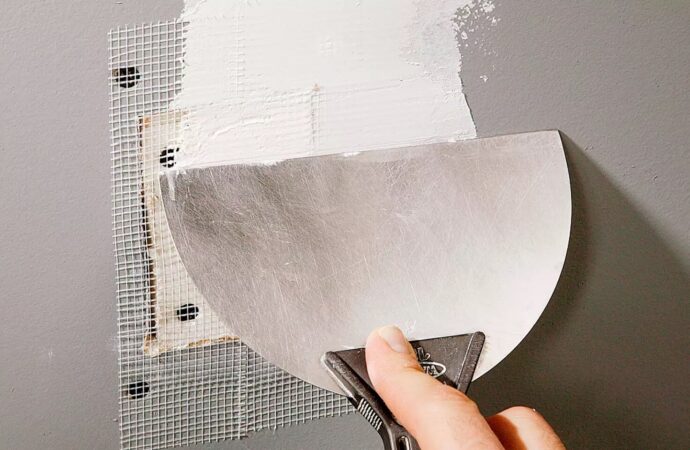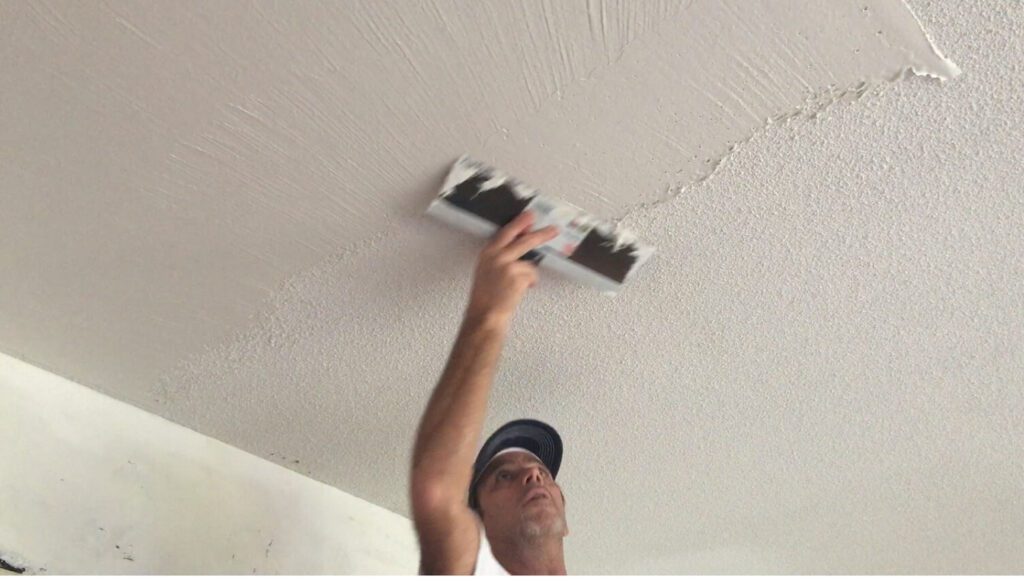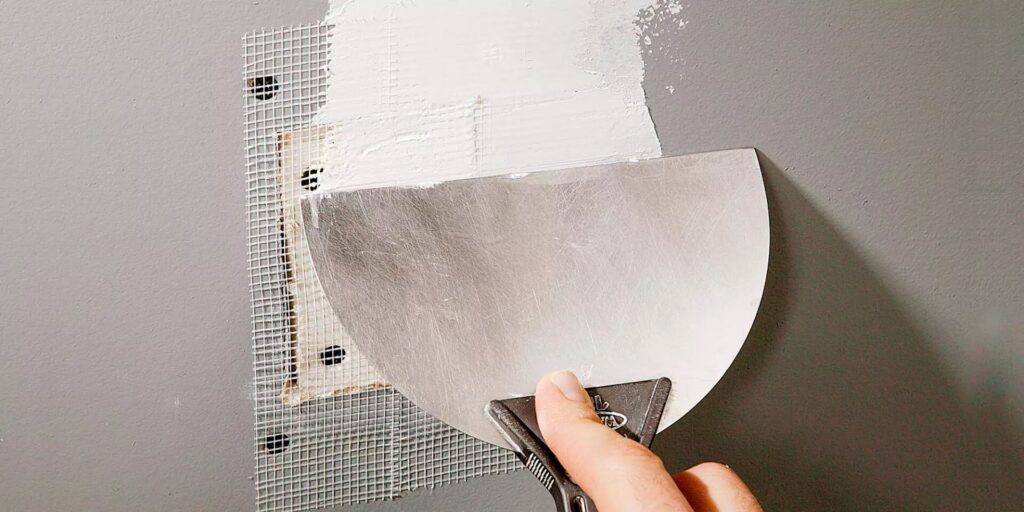Every homeowner must do drywall repair. Walls must be repainted to cover any minor damage they may have sustained over the years. Walls can also crack or become dented by moisture. However, drywall repair does not have to be difficult as you might think. It is one of the most straightforward home improvements you can make. This is the easiest way to fix small cracks and holes caused by drills or nails. Using a putty knife, you can cover the cracks and holes with lightweight spackle or putty. After the spackle has dried, it may be necessary to sand down the area to make it level with the rest. To blend the colors, apply a new coat of paint. For various reasons, nails, screws, or hooks can suddenly fall off our walls. It could be due to a shift in your wall frame, pressure on the wall or ceiling, or your builder failing to correctly secure the drywall onto its framing. Don’t panic if this happens. Just drive a new screw approximately an inch and a quarter away from where the old one was. Next, carefully place the old screw in its proper spot. Apply spackle to the areas you have repaired, and you will not see any damage. You can finish it off by applying a new coat of paint. You will be able to make essential repairs to damaged walls by the end of this article. If you have a family that is active and is prone to getting dents in the walls, there are some tools you can keep around the house. This article won’t provide enough information for significant repairs to drywall. Although major repairs are manageable, you need to know the basics. Here’s a list of some of the tools you will need. You can get essential tools at your local big box. These tools range in price from very cheap to high-end. You can find plastic putty knives starting at less than $1 and stainless steel, which, if taken care of properly, can last a lifetime. Plastic will work well if you only need to make a few repairs. You will also need a carriage bolt and a small hammer. Also, you will need a can of joint drywall material, 150-200 grit sandpaper, and a paintbrush. These tools can repair most minor dents and dings in drywall. A ding is caused by the doorknob’s locking button making an impression on the wall behind it. This is a common repair that can be done quickly. Take a look at the damage. Do you see anything sticking out above the wall? Use the carriage bolt to push any protrusions below the wall. The hammer can be used to push the protrusion below the wall surface and to round the edges. The next step is to use the putty knife, some joint compound, or, as it’s commonly known, drywall glue to fill the hole. After the mud has dried, you can sand the hole lightly to make the material the same height as the wall. Sand the wall again until it is smooth and level. Don’t over-sand. Over-sanding can cause the drywall to become rough and fray, requiring more mud to seal it. The surface should be uniform. You will get better results if you apply several small applications. Are things smooth? Apply more drywall mud if the walls are not soft. Sand again. Apply the primer once the border has become smooth. Once the primer has dried, you can apply regular wall paint. The primer is used to seal the wall to prevent the color from drying too quickly, allowing the patch to become visible. Drywall construction can bring many benefits to your home. Drywall is easy to mount. It’s cost-effective and fire-resistant. This wall is simple to mount, can be wallpapered and textured, and it’s also easy to repair. Maintaining dry walls is easy. Anyone can also do Drywall Repair. It’s easy to do yourself, with no need for specialized personnel. Don’t lose heart if you have to deal with Dry Wall Repair issues like cracks in the drywall, holes or damage from water leakage, problems with drywall tape, and damage to the ceiling. It is possible to restore it yourself! There is an easy way to repair holes. The essential tools you will need to fix holes are an extra drywall panel, sharp knives, joint compound, drywall glue, measurement scale, and paint or texture matching your walls. Take measurements of the hole you want to patch, then cut the drywall four inches larger than the measurement. Use the knife and measuring scale to cut two inches off each side of the wall patch. Place the patch over the hole and make the hole larger according to the size of your patch. The final step is to coat the holes with joint compounds and fix the patch. Finish the job by cleaning up any excess mixture. It is best to let it dry overnight. Once dry, apply another coat of compound and paint. This is a common scenario: You’re downstairs reading a book or watching TV when you hear the bag coming upstairs. You are shocked and run upstairs to investigate. Your child’s arm, leg, or head is sticking out of the wall. After the dust has settled, everyone is safe, and all punishments have been administered, it is time to repair the hole in your wall. It all depends on how big the hole is in the drywall. It all depends on how the hole is going to get fixed. It will be easier to select a smaller hole than a door handle. (which I’ll explain later). If the hole is minor, installing a large piece of drywall running from one stud into another might be more challenging. I also explain this. We will now drill a smaller hole. This will be done with a drywall saw and a utility knife. Once you have a clean area, cut a 1/2-inch strip of paper from the drywall. It should look like torn cardboard. Next, cut a piece of drywall slightly larger than the hole to be repaired. Next, cut away the backside of the piece so that it fits into the opening. The paper can then be left. This is known as a “patch cap.” Place the patch hat in the hole by applying drywall mud to the edges. Once the patch is in place, apply a coat to the ground. Let dry. After the mud has dried, remove any pieces and sand them smooth. Let it dry, and then do the same. Continue this process until your patch is soft and ready for painting. This is how you repair a small hole. It is the same procedure to fix a giant hole, except that we will need to remove the hole altogether. Use the drywall saw to cut the hole until you reach a stud. Now measure the mark and subtract 3/4 inch so you are halfway on the stud. You can make two marks and then snap a line. Or, you can use a flat edge to draw a line through both marks. That’s the line that you want to cut. Once you’re done, we can use the saw to trim the hole to the stud on either side. Add 3/4 inch to the measurement you took for the second mark. This will give you the equivalent of half the stud. Draw a line through the two marks. Use the framing square to draw a line through the hole at the top and bottom. Now you should have a square hole. Now, you will need to cut the piece you have marked. You will need to measure the hole and cut a piece that will fit inside it. After you have cut the piece, could you place it in the hole? Then nail the piece to the edges of the studs with a drywall nail. You can then mud it as in the second example. These are a few examples of how you can repair a hole in a wall. Drywall absorbs moisture like a sponge. Drywall can buckle and swell when it gets wet. This can compromise the integrity of your wall. This causes the underlying structures to be exposed to prolonged moisture, which leads to the decomposition process that eventually destroys the entire system. Drywall is a highly versatile building material. With some knowledge, drywall can be repaired if it has become wet. Use a drywall saw to cut around the damaged drywall. These handsaws can be purchased at a local hardware store for a low price. You should ensure that all drywall is removed by leaving a large margin around the defect. Identify the source of the water. This would be a simple step if outside forces like flooding or rain caused the water. However, it can be more difficult if there are plumbing or roof problems. You should call a professional if you cannot determine the water’s source. Replace wet drywall with dry. Mark a new patch of drywall with a razor blade or drywall saw. Screw into the hole using a screwdriver. Cut out any existing drywall not visible to the wall, and screw it into the hole. Apply drywall glue. The joint compound of drywall glue is applied in layers. Apply the first layer thickest. Cover all joints well and let dry. Don’t worry about getting the combination smooth. There will be layers of mud, sanding, and more before you get to your final coat. Allow all the mud to dry, and then sand it smooth. You can feel for any low or high points by running your hand across the joints. Mark these areas with a pencil. You can continue sanding the high spots, then apply a layer of mud to the entire repair. Make sure you concentrate on the low spots. Continue this process until the repair is in line with the wall. Be patient with this step. Your mud work will make it easier to build a smooth wall. Paint – Repaint the entire wall to match the color. The paint may not match the color of your division 100% even if it is tinted to match. This will give you a blatant reminder of the damage. You don’t need to paint the whole room, but it is possible to do so to maintain color consistency. We offer the above services at the following locations within West Palm Beach:
If you are located in Palm Beach County and you don’t see your city/area listed above, don’t worry! We cover all of Palm Beach County. Fill out the contact form above or CLICK HERE and send us a message. We’ll get back to you asap!
Drywall Repair
Contact Us

Small cracks and holes
Unfastened Fasteners

Follow These Steps to Repair Wet Plaster

Locations We Serve

